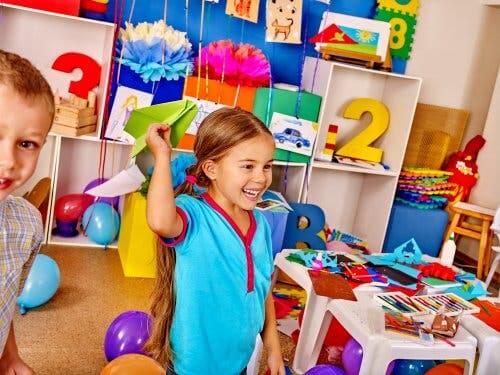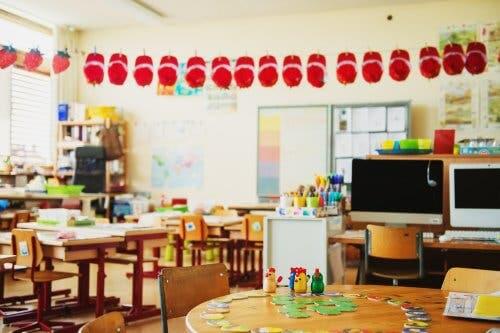How to Make a Classroom More Creative in a Simple Way


Written and verified by the teacher Azucena Fernández
Amid the pressure to keep up with the school curriculum, meet with parents, and teach daily classes, it can be hard to find time for creativity in the classroom. With so little free time, teachers may ask themselves if it’s possible to make a classroom more creative.
The answer is: yes, definitely. Creative classrooms not only look different but also feel different. They provide an environment in which students are more likely to express their ideas, go beyond thinking, challenge problems by devising innovative solutions, and, most importantly, learn faster and more effectively.
A nondescript classroom, with chairs and tables that can’t be moved, is a thing of the past. Currently, schools are more full of color and creativity and have more flexible designs that allow children to adapt to all kinds of learning.
How to make a classroom more creative: create a visual space for reflection
Reflection activities provide students the opportunity to absorb information in a deeper way and improve their creative and contextual understanding of content. When reflective learning exercises appear visually in a classroom, they can benefit every student.

Therefore, a good idea is to create a reflection board. Encouraging students to attach what they learn or discover on the board is a great opportunity for guided reflection.
Encourage hands-on learning
Hands-on learning is a great way to apply a creative twist to traditional content. Thus, it also engages students at a deeper learning level.
“Tell me, and I will listen; Teach me, and I’ll remember; Involve me, and I will learn.”
– Benjamin Franklin –
Ideas to make a classroom more creative
- English. It’s better to incorporate a group reading session in each class than to have each student read on their own. Each student will be selected as the daily reader and will take turns.
- Math. You have to look for practical ideas. For example, one way to address speed as content is to ask students to make paper airplanes and use calculations to predict their speed.
Have a flexible classroom setup
It’s important to keep your classroom flexible. This way, during class, students will be able to work on group projects, complete individual evaluations, listen to presentations, and many other activities, changing the order of chairs and tables.
To keep the creativity flowing between these different learning settings, the key is to keep the classroom design flexible so that you can rearrange it as you wish.
An interesting proposal to support this flexibility could be to create a permanent group table where students can meet whenever they need it. It’s important to experiment with different classroom setups, always checking to see if it’s ready for a variety of learning activities and work styles.

Encourage debate to make a classroom more creative
Encouraging students to have meaningful discussions is a good way to allow them to express new ideas and opinions. Productive discussions:
- Allow students to think critically about content.
- Challenge students to listen to the opinions of other students and to think creatively about their contributions and ideas.
- It gives them the opportunity to challenge each other intelligently and, also, to create from other people’s ideas.
Example: Create a reflective 10-minute session before the end of class or ask a member of a group to present their conclusions to the class.
Foster more color
Colors in classrooms don’t only have to be used in elementary school. Using color creatively and unconventionally in a classroom is one way to make a classroom more creative. For example, you can put up inspirational posters or create themed corners.
Therefore, it’s important to remember that the classroom is the center of each student’s learning journey. In this regard, making sure that it oozes creativity, physically and with activities, is one of teachers’ many privileges and duties.
Amid the pressure to keep up with the school curriculum, meet with parents, and teach daily classes, it can be hard to find time for creativity in the classroom. With so little free time, teachers may ask themselves if it’s possible to make a classroom more creative.
The answer is: yes, definitely. Creative classrooms not only look different but also feel different. They provide an environment in which students are more likely to express their ideas, go beyond thinking, challenge problems by devising innovative solutions, and, most importantly, learn faster and more effectively.
A nondescript classroom, with chairs and tables that can’t be moved, is a thing of the past. Currently, schools are more full of color and creativity and have more flexible designs that allow children to adapt to all kinds of learning.
How to make a classroom more creative: create a visual space for reflection
Reflection activities provide students the opportunity to absorb information in a deeper way and improve their creative and contextual understanding of content. When reflective learning exercises appear visually in a classroom, they can benefit every student.

Therefore, a good idea is to create a reflection board. Encouraging students to attach what they learn or discover on the board is a great opportunity for guided reflection.
Encourage hands-on learning
Hands-on learning is a great way to apply a creative twist to traditional content. Thus, it also engages students at a deeper learning level.
“Tell me, and I will listen; Teach me, and I’ll remember; Involve me, and I will learn.”
– Benjamin Franklin –
Ideas to make a classroom more creative
- English. It’s better to incorporate a group reading session in each class than to have each student read on their own. Each student will be selected as the daily reader and will take turns.
- Math. You have to look for practical ideas. For example, one way to address speed as content is to ask students to make paper airplanes and use calculations to predict their speed.
Have a flexible classroom setup
It’s important to keep your classroom flexible. This way, during class, students will be able to work on group projects, complete individual evaluations, listen to presentations, and many other activities, changing the order of chairs and tables.
To keep the creativity flowing between these different learning settings, the key is to keep the classroom design flexible so that you can rearrange it as you wish.
An interesting proposal to support this flexibility could be to create a permanent group table where students can meet whenever they need it. It’s important to experiment with different classroom setups, always checking to see if it’s ready for a variety of learning activities and work styles.

Encourage debate to make a classroom more creative
Encouraging students to have meaningful discussions is a good way to allow them to express new ideas and opinions. Productive discussions:
- Allow students to think critically about content.
- Challenge students to listen to the opinions of other students and to think creatively about their contributions and ideas.
- It gives them the opportunity to challenge each other intelligently and, also, to create from other people’s ideas.
Example: Create a reflective 10-minute session before the end of class or ask a member of a group to present their conclusions to the class.
Foster more color
Colors in classrooms don’t only have to be used in elementary school. Using color creatively and unconventionally in a classroom is one way to make a classroom more creative. For example, you can put up inspirational posters or create themed corners.
Therefore, it’s important to remember that the classroom is the center of each student’s learning journey. In this regard, making sure that it oozes creativity, physically and with activities, is one of teachers’ many privileges and duties.
All cited sources were thoroughly reviewed by our team to ensure their quality, reliability, currency, and validity. The bibliography of this article was considered reliable and of academic or scientific accuracy.
- Michaela Driver. (2010). Fostering Creativity in Business Education: Developing Creative Classroom Environments to Provide Students With Critical Workplace Competencies. Journal of Education for Business.
This text is provided for informational purposes only and does not replace consultation with a professional. If in doubt, consult your specialist.








